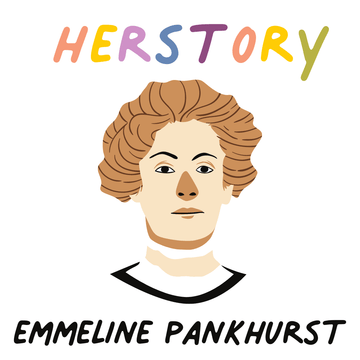HerStory
Emmeline Pankhurst HerStory

Emmeline Pankhurst was one of the most important British suffragette leaders. Her embrace of protest and aggressive action in the early 1900s marked a new phase in the battle for women’s votes.
As a 14-year-old, she attended a public meeting about women’s rights in Manchester, England in the early 1870s. From that point on, she was an active member in early British suffrage groups. They pushed not only for the vote, but also for equality for women in divorce and inheritance law.
By the early 20th century, Pankhurst had had enough with British political parties’ inaction on suffrage. She founded the Women’s Social and Political Union (WSPU) in 1903 to take confrontational action. The group targeted any political party that did not work towards votes for women.
The WSPU’s motto was “deeds, not words.” They marched in the streets with banners, coordinated chants, and trumpets. They also interrupted cabinet meetings, heckled politicians, and some members of the group set fires in mailboxes and vacant houses. They were arrested and imprisoned for civil disobedience. In prison, several of them went on hunger strikes and endured violent force-feedings.
Pankhurst and the WSPU had a significant influence on the American suffrage movement. The attention grabbing tactics of the WSPU marches inspired several American women studying in England at the time, including famous political activists Alice Paul and Lucy Burns. They brought these ideas and tactics home to the United States and subsequently formed the 1913 Woman Suffrage Procession and the "Silent Sentinels" pickets outside the White House. The organization they founded, the Congressional Union (later the National Woman’s Party), pushed for a constitutional amendment.
Due to these women’s activism, the 19th Amendment, giving American women the right to vote, was ratified in 1920. The fight continued for women’s rights in England, Wales, and Scotland until 1928, when women were finally afforded the right to vote.
As a 14-year-old, she attended a public meeting about women’s rights in Manchester, England in the early 1870s. From that point on, she was an active member in early British suffrage groups. They pushed not only for the vote, but also for equality for women in divorce and inheritance law.
By the early 20th century, Pankhurst had had enough with British political parties’ inaction on suffrage. She founded the Women’s Social and Political Union (WSPU) in 1903 to take confrontational action. The group targeted any political party that did not work towards votes for women.
The WSPU’s motto was “deeds, not words.” They marched in the streets with banners, coordinated chants, and trumpets. They also interrupted cabinet meetings, heckled politicians, and some members of the group set fires in mailboxes and vacant houses. They were arrested and imprisoned for civil disobedience. In prison, several of them went on hunger strikes and endured violent force-feedings.
Pankhurst and the WSPU had a significant influence on the American suffrage movement. The attention grabbing tactics of the WSPU marches inspired several American women studying in England at the time, including famous political activists Alice Paul and Lucy Burns. They brought these ideas and tactics home to the United States and subsequently formed the 1913 Woman Suffrage Procession and the "Silent Sentinels" pickets outside the White House. The organization they founded, the Congressional Union (later the National Woman’s Party), pushed for a constitutional amendment.
Due to these women’s activism, the 19th Amendment, giving American women the right to vote, was ratified in 1920. The fight continued for women’s rights in England, Wales, and Scotland until 1928, when women were finally afforded the right to vote.